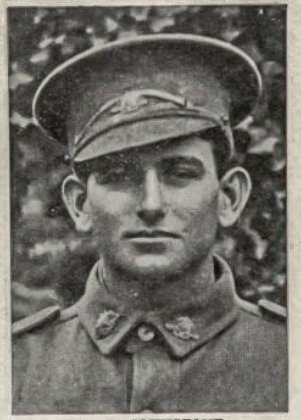George Henry JOHNSTON
Eyes blue, Hair dark, Complexion dark
George Johnston – He Came Good
Can you help us identify George?
George Henry Johnston was killed in Action at Fromelles. As part of the 53rd Battalion he was positioned near where the Germans collected soldiers who were later buried at Pheasant Wood. There is a chance he might be identified, but we need help. We are still searching for suitable family DNA donors. We are especially interested in family of any of George’s sisters, Florence, Mildred and Olive.
In 2008 a mass grave was found at Fromelles, a grave the Germans dug for 250 (Australian) bodies they recovered after the battle.
If you know anything of contacts here in Australia or England, please contact the Fromelles Association.
See the DNA box at the end of the story for what we do know about his family.
A Troubled Early Life
George Henry Johnston was born on 8 June 1894 at Liverpool, New South Wales to Albert Johnston and Florence Eliza Smith. He was the second of their seven children – Albert, George, Florence, Norman, Mildred, Dorian and Olive. Albert and Florence had never married, so all their children had their legal birth name registered as Smith. Albert worked as a labourer. Albert died in 1914 and Florence remarried, Joseph Edward Barry.
George attended Paramatta North Public School, but he had a troubled early life. In June 1906, at just 11, he was committed by a magistrate to the Reformatory Ship, Sobraon as an “uncontrollable child”. Truant, out late at night, loitering, bad companions, and his mother not in a condition to contribute to his support were all in the justification of this assignment. His parents did not object.
Source: Ancestry - New South Wales, Australia, Entrance Books for the Vernon and the Sobraon, 1867-1911 for George Johnston
There was a history of ‘trouble’ in his family. In the magistrate’s report on George, his father was noted as “whereabouts unknown”. Further back in the family, George’s great grandfather had been sent to Australia as a convict (theft) and it was noted that he did not play a role in raising his son, George’s grandfather. In later years, two of George’s brothers were arrested for lack of family support.
The Sabraon was a reformatory school based on a ship where wayward boys were taught seafaring and trade skills. For life on the ship, think sailor suits, nautical skills, hard work, and discipline. But also think picnics, gardening, and playing cricket on Cockatoo Island. There was a library, a games room, craft lessons and excursions.
Source: Sarah Luke, Like a Wicked Noah’s Ark: The Nautical School Ships Vernon & Sobraon, Australian Scholarly Publishing, 2020
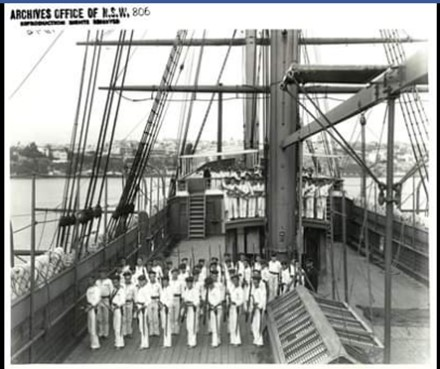
Near the end of his term, George was apprenticed from July to September 1909, after which he received a conditional pardon. He was still just 15 years old. His experience aboard the Sobraon seemed to have worked, there were no reported issues afterwards, either in the general public or in his military service. He worked as a labourer.
Off to War
George signed up to join the AIF on 31 August 1915 when he was 21. He was assigned to the 17th Battalion, 7th Reinforcements and began his military training at the Liverpool Camp. His brother Norman, who was underage, but had his mother’s consent, also served. Norman joined in February 1916 and was in the 45th Battalion (1940a). He survived the War. George’s 7th reinforcements left for Egypt on 20 December 1915 aboard the HMAT A29 Suevic for the month-long trip to Egypt.
There, they joined with the rest of the Battalion who had returned from Gallipoli and were guarding the Suez Canal. With the huge losses of men from Gallipoli and all the new recruits from Australia arriving in Egypt, major reorganizations and movement of personnel between units were underway. George was transferred from the 17th to the 53rd Battalion on 4 April, around the time that the 17th were leaving for the Western Front.
The 53rd Battalion had been formed on 16 February 1916 and were made up of Gallipoli experienced soldiers from the 1st Battalion and the new recruits from Australia. He remained at Ferry Post until 16 June, continuing his training and guarding the Suez Canal, when the 53rd began their move to the Western Front.
On 19 June, 32 officers and 958 soldiers of the 53rd left Alexandria on the Royal George, bound for Marseilles, France.
After arriving on 28 June, they were put on trains for a 62 hour ride to Hazebrouck and then marched to the camp at nearby Thiennes. During their trip it was noted that their ‘reputation had evidently preceded them’, as they were well received by the French at the towns all along the route.
Source: AWM4 23/70/2 53rd Battalion War Diaries July 1916 page 4
On 8 July they began a 30 km march to the front lines and were settled into billets in Fleurbaix on 16 July.
The Battle of Fromelles
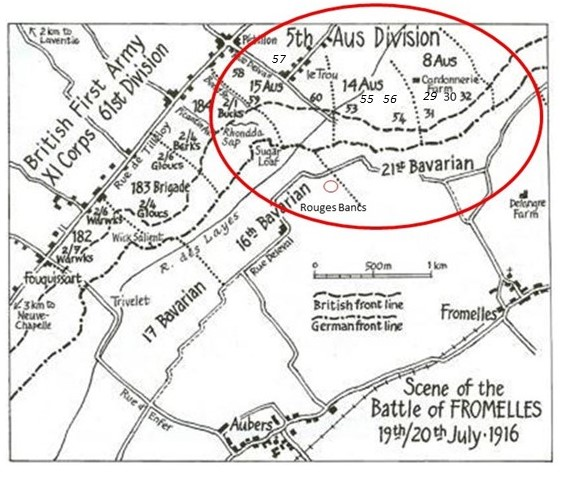
Early the next morning, the 53rd were moved straight into the front lines for an attack, but it was cancelled due to bad weather. They remained in the trenches in relief of the 54th. By 11/00 AM on the 19th heavy bombardment was underway from both armies. At 4.00 PM the 54th rejoined on their left. All were now in position for battle. The main objective for the 53rd was to take the trenches to the left of a heavily armed, elevated German defensive position, the ‘Sugar Loaf’, which dominated the front lines.
If the Sugar Loaf could not be taken, the 53rd and the other battalions would be subjected to murderous enfiled fire from the machine guns and counterattacks from that direction. As they advanced, they were to link up with the 60th and 54th Battalions on their flanks. The Australians went on the offensive at 5.43 PM. They moved forward in four waves – half of A & B Companies in each of the first two waves and half of C & D in the third and fourth.
They did not immediately charge the German lines, they went out into No-Man’s-Land and laid down, waiting for the British bombardment to lift. At 6.00 PM the German lines were rushed. The 53rd were under heavy artillery, machine gun and rifle fire, but were able to advance rapidly.
Corporal J.T. James of C Company (3550) reported:
“At Fleurbaix on the 19th July we were attacking at 6 p.m. We took three lines of German trenches”
As below, the 14th Brigade War Diary notes that the artillery had been successful and “very few living Germans were found in the first and second line trenches”, but within the first 20 minutes the 53rd lost ALL their company commanders, ALL their seconds in command and six junior officers.
Source: AWM C E W Bean, The AIF in France, Vol 3, Chapter XII, pg 369
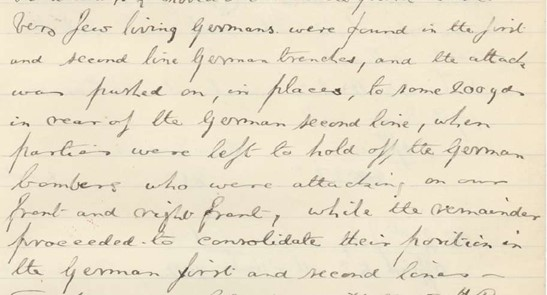
Some of the advanced trenches were just water filled ditches, which needed to be fortified by the 53rd to be able to hold their advanced position against future attacks. They were able to link up with the 54th on their left and, with the 31st and 32nd, occupy a line from Rouges Bancs to near Delangre Farm, but the 60th on their right had been unable to advance due to the devastation from the machine gun emplacement at the Sugar Loaf.
They held their lines through the night against “violent” attacks from the Germans from the front, but their exposed right flank had allowed the Germans access to the first line trench BEHIND the 53rd, requiring the Australians to later have to fight their way back to their own lines. By 9.00 AM on the 20th, the 53rd received orders to retreat from positions won and by 9.30 AM they had “retired with very heavy loss”.
Source: AWM4 23/70/2 53rd Battalion War Diaries July 1916 page 7
Of the 990 men who had left Alexandria just weeks before, the initial count at roll call was 36 killed, 353 wounded and 236 missing.
“Many heroic actions were performed.”
George was among the missing. To get some perspective of the battle, when Charles Bean, Australia’s official war historian, attended the battlefield two and half years later, he observed a large amount of bones, torn uniforms and Australian kit still on the battlefield. The final impact of the battle on the 53rd was that 245 soldiers were killed or died from their wounds and, of this, 190 were not able to be identified.
George’s Fate
Not unexpectedly, the details of George’s fate are unclear. There is a (partially illegible) witness statement by a soldier of C Company that said George was “last seen in the trenches on first wave and was wounded and believed to have been taken as a prisoner of war.”
Source: Australian Red Cross Wounded and Missing Files – George Henry Johnston, p 6
Another statement by Peter Hammond of A Company (3319, 3390 is incorrect in the Red Cross report) said that George had been able to advance to the German trenches, but was killed by a grenade.
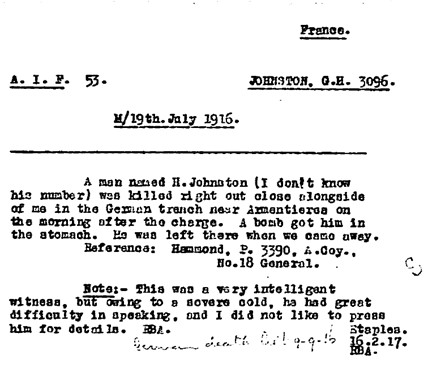
George’s mother Florence was advised that George was missing, but little other information was available for her. As in an August 1916 telex from her enquiries seeking further details, she was ‘anxious information’.

The Germans initially reported him as a Prisoner of War, BUT they also a later cite a date of his death of 19 July, i.e. during the battle. The first communication from the Germans was received on 5 October 1916.
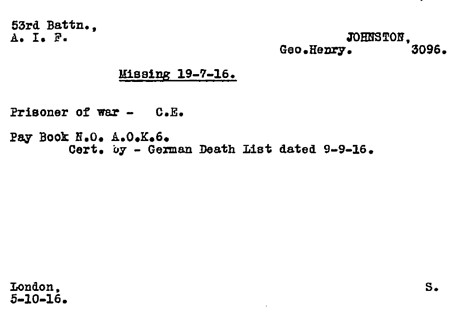
A further report was received from the Germans after the War.

Taking all of this information into consideration, it would seem likely that George had been badly wounded while near the German lines, but he was recovered/captured by the Germans, thus a prisoner of war, and then he died soon thereafter while in their care.
There are no records for his burial. George was awarded the Victory and British War Medals, a Memorial Scroll and Memorial Plaque.
He is commemorated at:
- V.C. Corner (Panel 8), Australian Cemetery Memorial, Fromelles, France,
- the Australian War Memorial (Panel 157), Canberra,
- The Ballarat Australian Ex-Prisoners of War Memorial.
Family at War
The Johnston family was deeply entwined in both world wars, with two sets of brothers serving in the First World War, and their sons continuing the legacy in the Second.
Brothers – George and Norman Johnston
- George Henry Johnston (3096, 53rd Battalion) was killed at Fromelles on the night of 19–20 July 1916 — the same battle in which his cousin Fred was lost.
- George's brother, Norman Dalwood Johnston (later Johnstone, Reg. No. 1940, 45th Battalion), fought on the Western Front and survived the First World War.
Cousins – Fred and Bertie Johnston
- Fred Johnston (3549, 54th Battalion) was killed at Fromelles on the night of 19–20 July 1916. His body was never found and his name is inscribed on the V.C. Corner Memorial alongside 410 Australians with no known grave.
- Fred's brother, Bertie Johnston (2627, 4th Battalion), enlisted in June 1915. He fought in Egypt, Gallipoli, and on the Western Front, earning promotion to Lieutenant before returning to Australia in 1919
The Next Generation
- Norman’s son, Raymond Dalwood Johnston (445230, RAAF), was killed in February 1945 in a training accident at Tocumwal, NSW.
- Bertie’s son, Arthur Henry Johnston (19195, RAAF), served as a Sergeant during the Second World War. He was a navigator in a Beaufighter aircraft and was killed in action over Borneo on 11 June 1945.
The Johnston family’s service and sacrifice spanned both world wars. From Egypt, Gallipoli, and the Western Front to Tocumwal and Borneo, the price of war echoed through generations.
While George had a troubled early life, he put all that behind him and gave his all for King and Country.

Can George still be found?
In 2008, a mass grave that had been dug by the Germans was discovered. It contained 250 bodies. As of 2024, 15 of the 190 unidentified soldiers from the 53rd have been found in this grave thru DNA matching from family members. 70 of the 250 soldiers remain unidentified from the grave.
As George died on the 19th while a prisoner of war, one of the remaining unidentified bodies could easily be George. We need family DNA donors to find out.
DNA samples are being sought for family connections to
| Soldier | George Henry (Smith) Johnston (1894-1916) |
| Parents | Albert William Johnston (1867-1914) b Pennant Hills NSW d Langlo Crossing, Queensland and Florence Eliza Smith (1868-1956) b Pennant Hills, NSW d Tascott, NSW |
| Siblings | Albert William (1892-1959) b Broadwater, Bellina, NSW d Auburn NSW m Lucy Ellen Gardiner | ||
| Florence Ernestine (1896-1959) b Casino, NSW m James Cook and Norman Odell | |||
| Norman Dalwood (1898-1969) b Sydney, NSW d Rockwood, NSW m Kathleen Winley | |||
| Mildred (1899-1924) b Paramatta, NSW d Paramatta, NSW m John Hanly | |||
| Dorian Phillip (1906-1969) b Paramatta, NSW d Paramatta, NSW m Dulcie Ford and Phyllis Thorsby | |||
| Olive Maud (1901-1977) b Paramatta, NSW d Gosford, NSW m Reginald Fahey |
| Grandparents | |||
| Paternal | Henry William Johnston (1831-1885) b Paramatta, NSW d Homebush, NSW and Sarah Ann Smith (1832-1904) b Beckley, Sussex, England d Manly, NSW | ||
| Maternal | John Smith (1837-1931) b Hastingfield, Cambridgeshire, England d Paramatta, NSW and Eliza Smith (1841-1938) b Castle Hill, NSW d Paramatta, NSW |
Seeking DNA Donors

Contacts
(Contact: carla@fromelles.info or geoffrey@fromelles.info).
(Contact: army.uwc@defence.gov.au or phone 1800 019 090).
Donations
If you are able, please contribute to the upkeep of this resource.
(Contact: bill@fromelles.info ).
